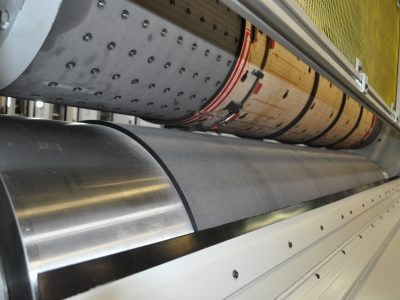Die cutting has long been a cornerstone in package manufacturing, playing a pivotal role in producing boxes efficiently and accurately. But what are the origins of this process and how is it evolving for the future?
The Origins of Die Cutting
Die cutting is a manufacturing process that dates back to the 19th century, with its roots in the shoe industry. In the mid-1800s, as industrialization was transforming manufacturing, shoe companies needed a more efficient way to cut leather. This led to the invention of the first die, a metal tool with sharp edges designed to cut or shape materials into specific forms or patterns when pressed against them. Over time, die cutting evolved to include more intricate designs, thanks to advancements in technology and engineering. Today, it’s a versatile technique used in various industries, from packaging and printing to automotive and electronics, allowing for precise and repeatable cuts in various materials.
Before die cutting, corrugated boxes were individually cut and prepared manually, with workers using hand tools to score and shape the cardboard. These boxes were simple, uniform and time-intensive to produce; but as consumer markets expanded and product differentiation became more important, manufacturers sought more flexible methods to create unique boxes efficiently.
This led to the technique called platen die cutting, which involves using a flatbed die-cutting machine to press a steel-rule die onto corrugated cardboard, cutting it into specific shapes with precision. Platen die cutting is still utilized in corrugated production today, particularly for packaging demanding very precise cuts and varying wall thicknesses.
Introducing the Rotary Die Cutter
In the 1950s and 1960s, the corrugated industry experienced a boom in automation and machinery, leading to more efficient die-cutting processes – namely, rotary die cutting. A rotary die cutter uses a cylindrical die mounted on a rotating drum to cut, score or perforate materials as they pass through the machine. As the material moves between the rotating die and an anvil or backup roller, precise cuts or impressions are made, allowing for the continuous production of custom shapes and designs.
Rotary die cutters can achieve speeds several times faster than traditional platen die cutters, as well as operate continuously, allowing for higher throughput and improved efficiency. This increased speed, combined with the flexibility to create intricate shapes, makes rotary die cutting ideal for high-volume production, offering a cost-effective solution for corrugated production.
Key Advancements in Rotary Die Cutting
While the core technology and functionality of rotary die cutters have remained relatively consistent over the decades, there have been significant technological improvements that have transformed their performance. These advancements have enhanced production speed, precision and versatility, allowing rotary die cutters to meet the demands of modern manufacturing.
Structural upgrades, such as reinforced frames, bearings and cutting drums, have increased the durability and extended the lifespan of rotary die cutters, significantly reducing maintenance requirements. This not only contributes to reduced operational costs but also ensures high-quality cuts. Advanced anvil technology, such as urethane anvil blankets and automatic anvil trimmers, also works to extend the lifespan of the cutting surface and to ensure consistent quality.
The Industrial Internet of Things (IloT) has also played a pivotal role in advancing rotary die cutters by connecting machines to networks for improved data analysis and operational insights. With IloT, operators can now monitor machine performance in real time, providing valuable data on production rates, wear and tear, and energy usage. This connectivity allows manufacturers to implement predictive maintenance, reducing downtime and extending the lifespan of equipment. Additionally, IloT integration has improved the precision and versatility of rotary die cutters, enabling them to adapt to changing production requirements with minimal manual intervention.
Digital Die Cutting
Introduced over a decade ago, digital die cutting has transitioned from a novel concept to a valuable tool for box converters. Unlike traditional die cutting methods that rely on physical dies, digital die cutting uses laser technology and digitally driven mechanical creasing, offering a more flexible and efficient approach to the cutting process. This advanced technology enables levels of precision and intricacy that surpass what rotary and platen die cutting can achieve, pushing the boundaries of packaging design.
With digital die cutting, converters can minimize setup times and eliminate the storage requirements of conventional dies. This flexibility allows for shorter production runs and rapid prototyping, enabling converters to take on rush jobs and address bottlenecks with ease. Furthermore, the digitally driven approach facilitates job consolidation onto a single sheet, reducing material waste and ensuring a favorable setup-to-production time ratio.
Beyond operational efficiency, digital die cutting opens new avenues for creativity and customization. The precision of laser cutting allows for intricate designs, cutouts, perforations and custom inserts, enabling converters to offer value-added packaging solutions with new levels of speed.
The Future of Die Cutting
Building on existing lloT technology, artificial intelligence (Al) offers transformative possibilities for die cutting. Al can bring enhanced efficiency and precision to the production process, allowing machines to automatically adjust settings based on real-time data analysis. This adaptability will lead to reduced downtime, lower waste and optimized resource utilization. By integrating Al-driven machine learning algorithms, corrugated equipment can identify patterns, predict maintenance needs and detect defects early in the production line, reducing costly errors and improving product quality. Al can also facilitate predictive analytics, helping companies forecast demand, automatically order parts and adjust production schedules accordingly.
While task automation has been steadily increasing in corrugated converting, it has long been limited to simple, repetitive tasks; however, new robotics are opening possibilities for streamlining complex activities currently being done by humans. For example, by integrating advanced robotics, companies may be able to achieve more consistent and accurate mounting of dies, reducing the risk of errors or misalignments. Additionally, robots can work in environments that may be hazardous to humans, promoting safety and efficiency.
Conclusion
Die cutting has evolved significantly since its origins, from simple metal tools to advanced, automated die cutters utilized across various industries. With new advancements on the horizon, die cutters continue to adapt and improve, while maintaining the foundational processes that have made it successful for over a century.
_____________________________________________________________________________________________________
Eric Aulton’s corrugated experience includes 25 years in engineering, and 11 in sales and product management. His SUN responsibilities are product management for rotary die cutting, assisting global and national accounts, cultivating strategic partnerships, and building advisory-type relationships with customers and peers, in an effort to support the growth of rotary die cutting platforms and other products offered by SUN Automation.
Originally published in Paper, Film & Foil Converter, July 2024


 SUN Spotlights Transformative Solutions & Partnerships at ExpoACCCSA 2024
SUN Spotlights Transformative Solutions & Partnerships at ExpoACCCSA 2024